Updated January 13, 2025 Authored by Dr. Chris Cloney and Jon Barrett of Dust Safety Science
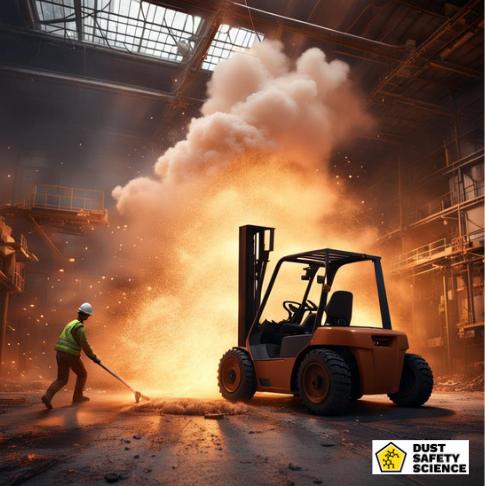
Key Takeaways:
- Awareness is Key: Recognize the hidden danger of combustible dusts in various industries and understand that raising awareness with explosive dust as an explosion hazard, among your team, is the first step in preventing combustible explosions and dust explosion prevention.
- Proactive Risk Assessment: Conduct thorough risk assessments and a dust hazard analysis to identify areas with combustible dust hazards. This proactive approach helps you pinpoint vulnerabilities and implement targeted dust explosion prevention measures and dust as an explosion hazard.
- Compliance is Non-Negotiable: Stay up to date with industry Combustible Dust regulations and standards. Compliance not only ensures safety but also safeguards your organization from legal consequences and fines.
- Prevention over Reaction: Prioritize prevention over reaction by investing in proper housekeeping practices, dust collection systems, and dust explosion protection measures. Explosion prevention significantly reduces the likelihood of a dust explosion.
- Continuous Learning and Improvement: Embrace a culture of continuous improvement in combustible dust safety. Regular training, education, and ongoing review of safety practices are essential to stay ahead of evolving explosion hazard risks, dust explosion prevention, and protect your workforce effectively.
Table of Contents:
- How Combustible Dust Explosions Occur
- Housekeeping to Prevent Combustible Dust Explosions
- Key Protection Measures for Combustible Dust Explosions
- HazLoc and UL Certified Dust Control Fans
- Combustible Dust Collection Systems
- Explosion Protection Systems and Protection from Combustible Dust Explosions
- The Role of Automation and IOT Software, Sensors and Detection, from Combustible Dust Explosions
- The Role of Artificial Intelligence, in Protection and Prevention of Combustible Dust Explosions
- Conclusion
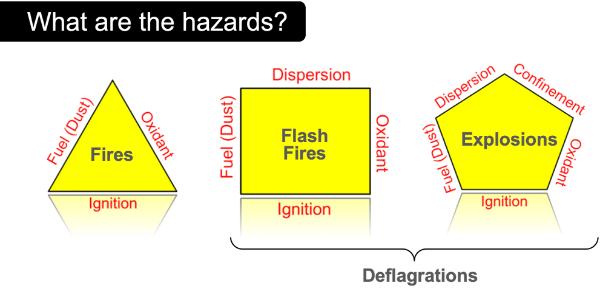
How Combustible Dust Explosions Occur
The scientific principles underlying combustible dust explosions include the detailed breakdown of the combustion process, the factors that influence dust explosions, and key concepts such as Minimum Ignition Energy (MIE), Minimum Explosible Concentration (MEC), and others. According to the Occupational Safety and Health administration, (OSHA), any solid that can catch fire can become explosive when turned into dust. Elements of a Dust Explosion OSHA states that five elements must be present for a dust explosion to occur. According to the National Fire Protection Association, (NFPA), as little as 1/32nd of an inch of dust buildup (the thickness of a dime) is enough to cause an explosion.
Detailed Breakdown of the Combustion Process: Dust explosions follow a sequence of events that can be understood as a complex chemical reaction, known as the fire triangle, with three key elements: fuel, oxygen, and ignition source
Fuel: Fine particulate matter, such as dust or powdered materials, and unique chemical composition, serves as the fuel. Dust accumulation can originate from various sources, including wood dust, metals, plastics, chemicals, and organic materials.
Oxygen: The oxygen in the air acts as an oxidizer, required for combustion to occur.
Ignition Source: An ignition source, which can be a spark, static electricity, open flame, hot surface, friction, or electrical discharge, initiates the combustion process.
Dust Suspension: Dust become suspended in the air, forming a particulate cloud. The concentration of dust in the cloud must be within a specific range to support an explosion.
Ignition: A dust cloud encounters an ignition source, such as static electricity, causing the combustion of the suspended dust.
Rapid Combustion: The combustion propagates throughout the particulate cloud at an astonishingly high rate, generating pressure waves and fireballs, leading to an explosive release of energy.
Factors Influencing a Dust Explosion (Fire Triangle for Dust):
The factors that influence dust explosions can be conceptualized using a “Fire Triangle” analogy, which includes three key elements:
Fuel (Combustible Dust): The type and properties of the combustible dusts play a significant role in the likelihood of an explosion. Factors such as particle size, very small particles, shape, chemical composition, and moisture content affect the explosiveness of the dust.
Oxygen (Air): The availability of oxygen in the air, often expressed as oxygen concentration, must be within a specific range to support combustion. Insufficient or excess oxygen can inhibit explosion propagation.
Ignition Source: The presence of an ignition source can ignite combustible dust. Common sources include electrical equipment, welding operations, abrasive blasting, friction from moving machinery, and hot surfaces. Preventing or mitigating potential ignition sources is a key safety measure.
Key Terms and Concepts:
Minimum Ignition Energy (MIE): MIE is the minimum amount of energy required to ignite a dust cloud when the air-fuel mixture is within its explosible range. It is typically measured in millijoules (mJ).
Minimum Explosible Concentration (MEC): MEC is the lowest concentration of combustible dust in the air that can support a dust explosion when an ignition source is present. Below this concentration, the mixture is too lean to explode; above it, the mixture is too rich.
Dust Cloud Flammability Limits: These limits define the range of dust concentrations in which an explosion can occur. The lower explosive limit (LEL) and upper explosive limit (UEL) are specific concentrations below and above which explosions cannot occur.
Dust Deflagration: A dust deflagration is a rapid combustion of dust that propagates at subsonic speed, generating pressure and fire but not a shockwave.
Dust Detonation: A dust detonation is a supersonic combustion that produces shockwaves, leading to more destructive explosions. These are uncommon in most industrial processes, but may be possible in coal mining applications.
Understanding the science behind combustible dust explosions, along with these key terms and concepts, is crucial for industries that handle combustible materials and explosive dust and prevent dust explosions. Industries which generate combustible dust can assess and mitigate the risks associated with dust, and a flash fire, ensuring the safety of workers and preventing materials which can catch fire and cause catastrophic incidents. A Dust Hazard Analysis should be performed on a regular basis, to identify dust prone areas. Regarding a combustible dust explosion pentagon, five elements must be present for a dust explosion to occur are fuel, oxygen, ignition, dust dispersion, and confinement of the dust cloud. If one element of the five elements is missing, an explosion Pentagon will not occur.
Housekeeping to Prevent Combustible Dust Explosions

Housekeeping Practices: Regular cleaning to minimize combustible dust accumulation.
One of the fundamental key prevention measures for mitigating the risk of dust explosions is the implementation of robust housekeeping practices. Prevention includes not using compressed air, fans, or brooms for cleaning, as these processes might create a dust cloud. Regular and thorough cleaning of workspaces is essential to minimize the accumulation of combustible dust and dust explosion prevention. This proactive approach is a critical component of maintaining a safe environment and to prevent dust explosions in industries where dust is prevalent, such as manufacturing, agriculture, and food processing.
The Importance of Regular Cleaning
Regular cleaning serves as the first line of defense against dust hazards and to prevent combustible dust explosions. When dust particles are allowed to accumulate over time, in ventilation systems and overhead suspended ceilings, they create an environment ripe for potential explosions. These tiny particles, often unseen to the naked eye, can become suspended in the air, waiting for the right conditions to ignite and trigger a devastating explosion. Safety measures include keeping work areas clean, the amount of dust available for dispersion, a flash fire, and combustible dust hazards are significantly reduced, including explosion prevention.
Best Practices for Housekeeping
Effective housekeeping practices involve a combination of strategies and best practices:
- Scheduled Cleaning: Establish a routine cleaning schedule to ensure that work areas, equipment, and surfaces are cleaned regularly from combustible dusts, for explosion prevention. The frequency of cleaning should be tailored to the specific conditions of each workspace, including suspended ceilings.
- Proper Tools and Equipment: Use appropriate cleaning tools and equipment, such as industrial vacuums, dust collectors, and cleaning solutions, to effectively capture and remove combustible dusts without dispersing it into the air, for explosion prevention.
- Comprehensive Dust Removal: Ensure that all areas, including suspended ceilings, overhead structures, crevices, and hidden corners, are thoroughly cleaned to prevent dust accumulation.
- Safety Training: Train employees on safe combustible dusts cleaning procedures, emphasizing the importance of following safety guidelines to minimize the risk of ignition, such as static electricity, during the cleaning process.
- Controlled Disposal: Establish protocols for the safe disposal of collected dust to prevent its reintroduction into the environment. Dust collected should be safely stored in designated containers.
The Role of Management and Employees with Housekeeping
Effective housekeeping practices require a commitment from both management and employees to prevent combustible dust explosions. Housekeeping practices are part of a Dust Hazard Analysis. Management should lead by example, providing the necessary resources, risk assessments, training, and support for the implementation of these practices. Training includes not using compressed air, fans, or brooms for cleaning, as these processes might create a dust cloud. Reporting any concerns or deviations from established cleaning schedules is vital for ensuring that housekeeping practices remain effective.
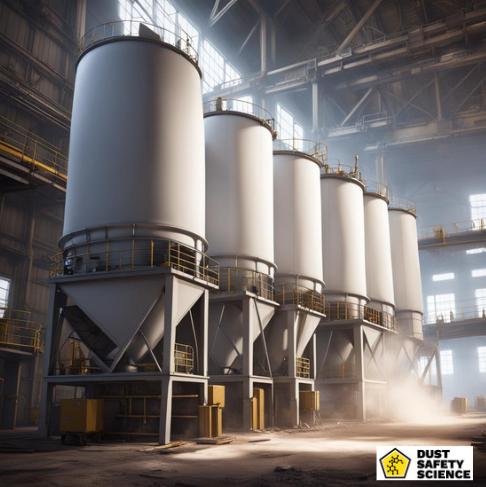
Additional Key Measures to Prevent Combustible Dust Explosions
Dust explosions are violent and often devastating events that occur when fine, dry particles of combustible materials become suspended in the air and then ignite, leading to a rapid release of energy. Key elements necessary for a combustible dust explosion include fuel (the combustible dust), oxygen (present in the air), and an ignition source (typically a spark, open flame, or even hot surfaces).
The sequence of events leading to a combustible dust explosion involves the dispersion of dust particles in the air, the formation of a dust cloud, ignition, and the subsequent rapid combustion of the cloud, resulting in pressure waves, fireballs, and potential damage. Several key protection measures designed to minimize the damage and risks associated with dust explosions include:
HazLoc and UL Certified Dust Control Fans
HazLoc and UL certified dust control fans can play a role in handling combustible dust in industrial settings. The National Fire Protection Association recently approved dust control fans, in Section 9.6.3 of NFPA 652, as a viable solution to prevent dust explosions. These dust control fans are designed and certified for Class II, Div. 1 and Class II, Div. 2 environments and to prevent dust accumulation on high surfaces, reducing the risk of dust explosions, which can occur when fine particles become airborne and ignite. Dust control fans use high-velocity airflow to create an air curtain and air barrier, preventing them from settling and accumulating. By continuously circulating air, these fans help maintain cleaner environments, reducing the likelihood of hazardous dust concentrations. This proactive approach is essential in industries like food processing, woodworking, and manufacturing, where combustible dust can pose significant safety risks.
Safety precautions are vital when using dust control fans to handle combustible dust. The dust control fans need to be properly installed and maintained, following manufacturer guidelines and industry standards. Regular inspections and cleanings are necessary to ensure optimal performance and prevent dust buildup within the fans as well. Additionally, facilities should implement comprehensive dust control programs, including proper housekeeping practices, dust collection systems, and employee training on dust hazard awareness. Case studies have shown that the use of dust control fans significantly reduces dust accumulation, enhancing workplace safety. Case studies have shown a reduction in combustible dust levels after installing these dust control fans, demonstrating their effectiveness in mitigating dust explosion risks. Another study highlighted a food processing plant that achieved substantial dust control improvements, leading to compliance with stringent safety regulations and reduced maintenance costs.
Combustible Dust Collection Systems
Combustible dust poses a significant safety hazard in various industrial settings, making the selection of appropriate dust collection systems crucial. Different types of combustible dust collection systems are designed to capture and contain dust particles to prevent potential explosions or fires. Here, we discuss various dust collection systems and their key characteristics:
Cyclone Separators: Cyclone separators use centrifugal force to separate dust from the air stream. These systems are effective in capturing larger particles and can pre-separate materials before more advanced filtration methods. Cyclone separators are commonly used in initial stages of dust collection.
Baghouses: Baghouses are equipped with fabric filter bags that capture dust as air passes through them. They are efficient in capturing fine particles and can handle high air volumes. Baghouses are suitable for a wide range of applications and industries.
Cartridge Collectors: Cartridge collectors use cylindrical filter cartridges to trap dust particles. They are versatile, efficient, and compact, making them suitable for facilities with limited space. Cartridge collectors are known for their ease of maintenance and filter replacement.
Wet Dust Collectors: These dust collector systems use water or other liquid to capture and suppress dust. Wet dust collectors are particularly effective for handling explosive dust as they can eliminate the risk of ignition. They are commonly used in industries dealing with metalworking and explosive materials when using abrasive blasting. However, it is important to keep in mind that some metals may also react with liquids and to account for this in your Dust Hazard Analysis.
Electrostatic Precipitators: Electrostatic precipitators use an electrostatic charge to attract and collect dust particles on charged plates or wires. They are effective for removing fine particles, and they require less frequent filter replacement. However, they can be complex to operate and maintain.
Ventilation and Dilution: This method involves diluting the dust-laden air with clean air and exhausting it outdoors. While not a collection system per se, it can be a practical approach for reducing dust concentration in the workplace.
Each type of combustible dust collection system and dust collector has its advantages, limitations, safety measures, and the choice depends on factors such as the type of dust generated, process requirements, available space, and regulatory compliance. It’s crucial for industries to assess their specific needs and consult with experts to select the most suitable dust collector and dust collection system to enhance safety measures and prevent dust-related incidents.
Explosion Protection Systems and Protection from Combustible Dust Explosions:
Explosion Venting Systems: Installing explosion vents and devices that can mitigate the pressure buildup of an explosion in an enclosure, to reduce the risk of an explosion, in a confined space.
Principle: Explosion venting systems are designed to release pressure and flames resulting from a dust explosion in a controlled manner. They divert the explosion’s force away from personnel and equipment.
Key Benefits: By redirecting the explosion’s energy, these systems reduce the potential for structural damage, mitigate the risk of secondary explosions, and protect human lives.
Explosion Suppression Systems:
Principle: Explosion suppression systems work by rapidly detecting the early stages of a dust explosion and releasing a fire-extinguishing agent to quell the explosion before it reaches a critical stage.
Key Benefits: These systems can swiftly suppress an explosion, preventing it from progressing and causing widespread damage. They are particularly effective in enclosed or confined spaces.
Isolation Systems:
Principle: Isolation systems are designed to prevent the propagation of a dust explosion from one piece of equipment to another or from one part of a facility to another. This involves the use of barriers or isolation devices.
Key Benefits: Isolation systems are critical in containing an explosion, minimizing its reach, and protecting areas or equipment not directly involved in the initial explosion.
Flameless Venting Technology:
Principle: Flameless venting technology is designed to release the pressure and flames resulting from an explosion while preventing external flames from entering the protected environment. It involves specialized venting panels equipped with a flame arrestor and quenching media. When an explosion occurs, the venting panel opens, and the ignited dust and gas mixture is forced through the flame arrestor. The flame arrestor cools and extinguishes the flames, ensuring that they do not propagate beyond the venting panel.
Flameless venting systems are designed to capture and extinguish flames generated during an explosion. They help prevent secondary explosions and provide additional protection in case of a dust explosion.
Key Benefits: Flameless venting technology effectively mitigates the destructive force of an explosion. By preventing the release of flames and pressure, it reduces the potential for secondary explosions and minimizes damage to equipment and structures.
Inerting Systems:
Principle: Inerting systems introduce inert gases, such as nitrogen, to reduce the oxygen content in enclosed spaces, making it difficult for dust explosions to occur. This is a proactive measure to prevent explosions from taking place in the first instance.
Key Benefits: Inerting systems prevent the ignition of combustible dust by removing the oxygen necessary for combustion. This fundamental principle significantly reduces the risk of dust explosions. Inerting systems can maintain the inert atmosphere continuously, ensuring that the protected space remains safe even during normal operations or process upsets.
Intrinsically Safe Equipment:
Principle: The use of intrinsically safe equipment ensures that electrical and mechanical devices within potentially hazardous areas are designed to prevent the generation of sparks or heat that could ignite combustible dust.
Key Benefits: These safety measures significantly reduce the risk of ignition within areas where combustible dust is present, making it safer to operate equipment.

The Role of Automation and IOT Software, Sensors and Detection, in Protection and Prevention of Combustible Dust Explosions
Manufacturing facilities and industries are turning to automation and IoT, (Internet of Things), technologies for enhanced safety measures, protection and prevention, from dust explosions. Some technologies to implement for combustible dust protection and prevention include:
Combustible Dust Explosion Risk Assessment Software: Advanced software tools enable companies to assess and quantify the risk of dust explosions within their facilities, including a Dust Hazard Analysis. These applications consider factors like dust particle size, concentration, and ignition sources, allowing for the identification of high-risk areas.
Dust Sensors and Detectors: Specialized sensors and detectors have been developed to continuously monitor airborne dust levels. These real-time devices can trigger alarms or automatic shutdowns when dust concentrations reach dangerous levels, preventing the accumulation of hazardous materials.
Dust Control and Ventilation:
Automation systems can monitor and regulate the airflow, dust collection, and ventilation systems to maintain optimal conditions and prevent dust from accumulating. By constantly adjusting these parameters, automation ensures that the dust concentration remains below the MEC, reducing the risk of an explosion.
Housekeeping:
Automation can control industrial cleaning equipment such as vacuum systems and robotic sweepers, reducing the accumulation of combustible dust in the workspace. Regular cleaning routines can be scheduled and carried out without human intervention, ensuring that dust accumulation does not occur over time.
Intrusion Detection:
Automated security systems can monitor unauthorized access to critical areas and prevent entry by personnel not trained in dust safety. This prevents the introduction of potential ignition sources into hazardous environments.
Real-time Monitoring:
IoT devices and sensors can continuously monitor environmental conditions, including temperature, humidity, and dust concentration. This real-time data can be transmitted to a central control system, allowing operators to detect potential hazards and take immediate action to prevent a dust explosion.
Early Warning Systems:
IoT sensors can trigger early warning systems when dust concentrations reach critical levels. These systems can alert operators and initiate predefined safety protocols, such as shutting down equipment or initiating emergency response procedures, preventing clouds and dust explosion.
Predictive Maintenance:
IoT technology can facilitate predictive maintenance of equipment by monitoring the performance of machinery, filters, and dust collection systems. This ensures that these components are functioning correctly, reducing the risk of equipment failures and prevent clouds and dust explosions.
Video Surveillance:
IoT-enabled surveillance cameras can monitor areas at risk of dust explosions, allowing operators to remotely inspect and respond to potential issues. This not only enhances safety but also aids in post-incident investigations.
Dust explosions can have catastrophic consequences, but the integration of automation and IoT technologies into a Dust Hazard Analysis, provides powerful tools for increased safety measures, protection and prevention. By automating critical processes, monitoring environmental conditions in real-time, and enabling early warning systems, industries can significantly reduce the risks associated with combustible dust, clouds, and a dust explosion.
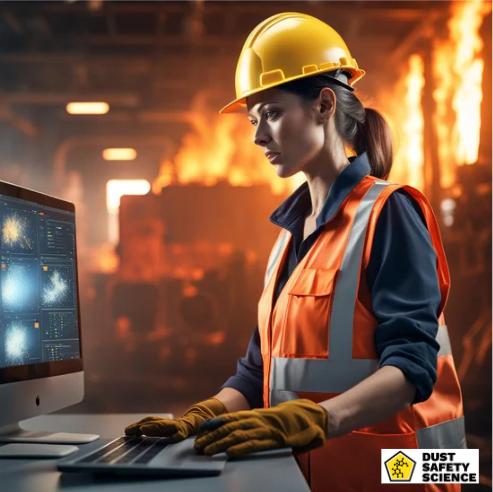
The Role of Artificial Intelligence, in Protection and Prevention of Combustible Dust Explosions
Data Analytics and Predictive Insights:
Artificial Intelligence, (AI), can analyze vast amounts of data from sensors and historical records to identify trends and patterns associated with dust concentration, humidity, temperature, and equipment performance. By understanding these trends, AI systems can predict potential dust explosion hazards before they reach critical levels, and prevent clouds and prevent dust explosions.
Early Warning Systems:
AI can be integrated with real-time monitoring systems to develop early warning systems. These systems use AI algorithms to detect deviations from normal conditions and trigger alarms or initiate safety protocols when the risk of a cloud and dust explosion is elevated.
Predictive Maintenance:
AI can facilitate predictive maintenance by continuously monitoring equipment health, including dust collection systems, filters, and machinery. Through machine learning, AI can predict when maintenance is required, reducing the risk of equipment failures that might trigger a cloud and prevent dust explosions.
Optimizing Dust Control and Ventilation:
AI can control dust collection systems and ventilation to maintain optimal conditions by constantly adjusting airflow and equipment settings. This proactive management helps prevent the accumulation of combustible dust, and prevent dust explosions.
Emergency Response Planning:
AI can contribute to more effective emergency response plans. By analyzing historical data, AI systems can help develop better-informed response strategies, ensuring that actions are taken swiftly in the event of an emergency, and to prevent dust explosions.
Automation of Safety Procedures:
AI-driven automation can manage safety protocols, such as shutting down equipment or activating fire suppression systems, when a potential hazard is detected, to prevent a dust explosion.
Identification of Ignition Sources:
AI can analyze video surveillance footage to identify potential ignition sources, such as sparks or overheated equipment. This capability enables prompt intervention to prevent a dust explosion.
Artificial intelligence has emerged as a potent tool for preventing dust explosions. By leveraging AI’s ability to analyze extensive datasets, identify patterns, and make real-time decisions, industries can significantly enhance their safety measures.
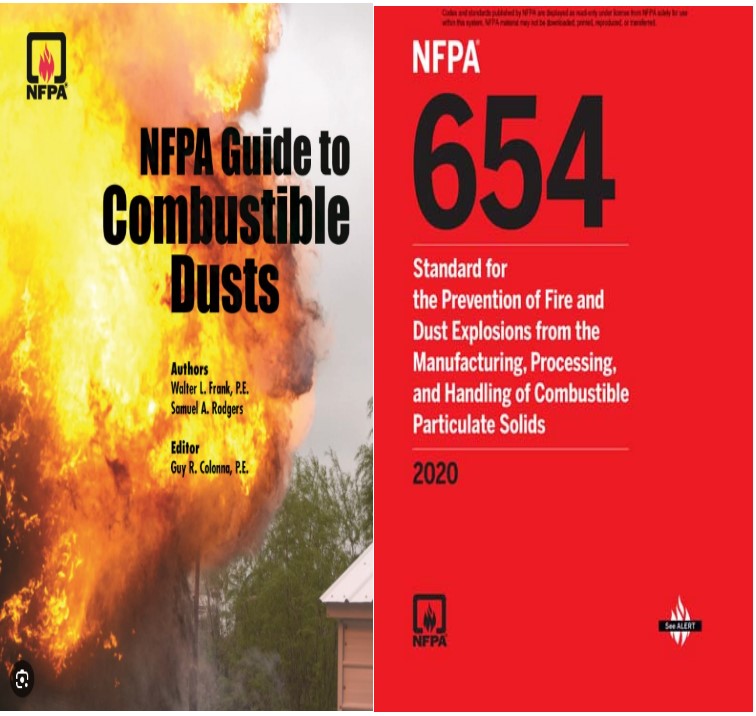
Conclusion
Understanding and preventing dust explosions is paramount to ensuring workplace safety, protecting lives, and mitigating the devastating consequences that such incidents can bring.
Importance of Preventing and Protection from Dust Explosions:
Preventing dust explosions is not merely a regulatory requirement; it is an ethical and practical imperative. The consequences of these incidents extend beyond financial losses and legal liabilities, encompassing the loss of human lives and environmental damage. A comprehensive understanding of how to prevent combustible dust explosions and hazards and the commitment to prevention can lead to:
Safety Enhancement: Protecting the lives of workers and the public by minimizing the risk of explosions.
Legal Compliance: Avoiding penalties, fines, and legal consequences associated with non-compliance.
Positive Reputation: Attracting customers and business partners by demonstrating a commitment to safety.
Insurance Benefits: Reducing insurance costs and improving coverage options.
Continuous Improvement: Fostering a culture of ongoing safety improvement and risk reduction within organizations.
Recommendations for Further Reading and Resources:
- NFPA Standards: Explore the National Fire Protection Association’s guidelines and standards related to combustible dust (NFPA 652, NFPA 654, etc.).
- OSHA Resources: The U.S. Occupational Safety and Health Administration (OSHA) offers valuable resources on combustible dust safety.
- European ATEX Directive: Study the ATEX directive for European Union member states, which focuses on equipment used in potentially explosive atmospheres.
- Industry Publications: Many industry-specific publications and journals provide in-depth information on combustible dust hazards and prevention measures.
- Safety Training Programs: Consider enrolling in safety training programs that cover dust safety and risk assessment.
- Government Guidelines: Review the guidelines and resources provided by relevant government agencies in your region, such as the Health and Safety Executive (HSE) in the UK.
- International Safety Organizations: Explore international safety organizations and their publications, like the Institution of Chemical Engineers (IChemE).
Understanding and preventing combustible dust explosions is an ongoing and crucial endeavor for industries worldwide. The importance of safety, compliance, and a proactive approach cannot be overstated, as these measures protect lives, assets, and the environment. By staying informed, adopting best practices, and fostering a culture of safety, organizations can effectively reduce the risk of dust explosions and contribute to safer workplaces globally.
About Dust Safety Science
Dr. Chris Cloney, of Dust Safety Science, provides additional Combustible Dust information, with a Podcast. Click on the latest Podcast Link: 10 Videos to Demonstrate and Educate About Dust Explosion Hazards

Resources:
Visit Dust Safety Science (Global Incident Tracking)
Visit Dust Safety Academy (Resources, Training and Events)
Visit Dust Safety Professionals (Need Help? Get Support Today!)
Visit Dust Safety Journal for the Dust Safety Science Monthly Journal
Subscribe to our Dust Safety Science Newsletter at Dust Safety Science Newsletter
Visit the Dust Safety Science blog for written articles on combustible dust safety including the latest research, expert opinions, and state-of-the art in fire and explosion protection.
